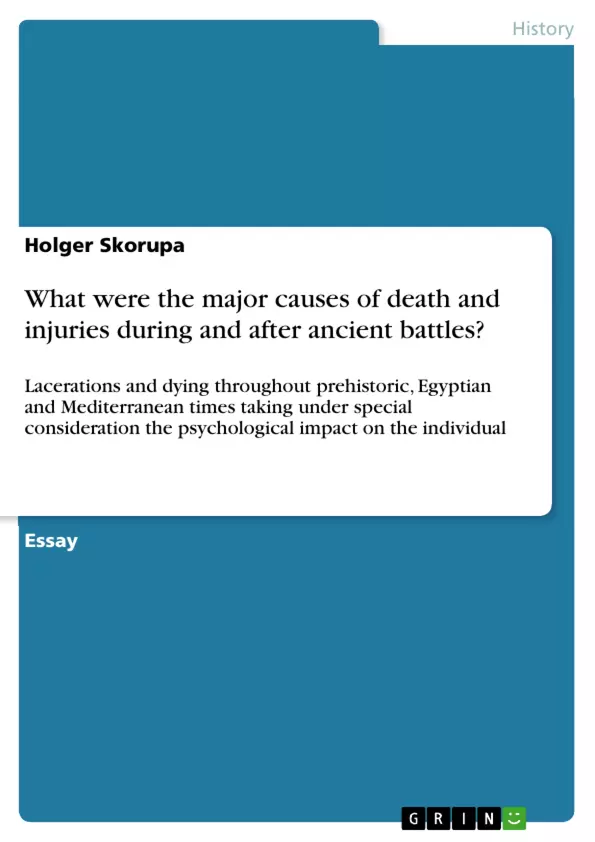(...) all infantry actions, even those fought in the closest of close order, are not, in the last resort, combats of mass against mass, but the sum of many combats of individuals – one against one, one against two, three against five. This must be so, for the very simple reason that the weapons (...) are of very limited range and effect.”
As Keegan suggest in his Face of Battle – one of the most reviewed, criticized, but also honoured publication stressing warfare and its impact on the single warrior facing both the receipt of rewards and death – that any kind of combat appears to be an individual conflict, either. This circumstance has not been changed over all periods of violent actions between human beings. For the last decades, even the myth of a peaceful prehistoric community has been declared to be wrong-turned. However only few historical, anthropological or sociological/psychological works seem to be of large interest questioning the causes of death, fatal wounds and injuries throughout a war, even though this (my Italics) might be a timeless interrogation. This paper, hence, will not demand to revolutionize the hiatus of research on the central question, but it attempts to allow an insight into the circumstances of prehistoric, Egyptian and Mediterranean warfare. By underlining especially the most common lesions of these periods as well as pointing out the reasons behind apparently unnecessary casualties, it will give a short introduction to a warrior‟s/soldier‟s particular behaviour while battling. Additionally the paper tries to offer both various arguments, which may support Keegan‟s intention referring above and – which appears to be even more important – a critical view to the reader to obtain an objective review. As a result, it will be undoubtedly significant to elucidate as much archaeological, textual and visual sources as possible including the interpretative utilization of currently discussed examines due to the central of the paper.
Prehistoric warfare was underestimated in perspectives of offering only little substantial evidence stressing the causes of death and injuries during and after battle actions for a long time.
[...]
Table of Contents
- Prehistoric Warfare
- Archaeological Evidence
- Skeletal Evidence
- Lesions Caused by Penetration
- Blunt Force Wounds
- Cannibalism and Hunting Methods
- Interpreting Skeletal Indications
- Causes of Death and Lacerations
- Ancient Egyptian Warfare
- Visual and Textual Sources
- Common Lesions and Wounds
- Combat Strategies and Tactics
- Psychological Impact on Warriors
- Mediterranean Warfare
- Historical Sources
- Ancient Greek and Roman Accounts
- Military Tactics and Strategies
- Types of Weapons and Combat
- Wounds and Injuries in Battle
- Psychological Impact on Soldiers
Objectives and Key Themes
This paper explores the major causes of death and injuries during and after ancient battles, specifically focusing on prehistoric, Egyptian, and Mediterranean warfare. It aims to provide insight into the circumstances of these conflicts, analyze the most common types of wounds, and examine the reasons behind potentially unnecessary casualties. Key themes addressed in the paper include:- The prevalence of individual combat in ancient warfare
- The challenges of interpreting archaeological evidence
- The role of weapons and combat techniques in inflicting injuries
- The psychological impact of battle on warriors and soldiers
- The enduring relevance of ancient warfare for understanding contemporary conflict
Chapter Summaries
Prehistoric Warfare
This chapter explores the challenges of researching prehistoric warfare due to limited evidence. The primary sources for understanding prehistoric battle injuries are archaeological findings, particularly skeletal remains. The chapter examines various types of injuries, including those caused by projectile weapons, bladed weapons, and blunt force trauma. It also discusses the controversial issue of cannibalism and its potential role in survival strategies.Ancient Egyptian Warfare
The availability of sources for studying Egyptian warfare shifts significantly compared to prehistoric times. This chapter highlights the importance of tomb scenes, reliefs, and textual sources in understanding Egyptian battle practices. It analyzes the types of wounds sustained in Egyptian warfare and explores the strategies and tactics employed by combatants.Mediterranean Warfare
This chapter examines the use of historical sources to reconstruct Mediterranean warfare, focusing primarily on ancient Greek and Roman accounts. It explores the diverse military tactics and strategies prevalent in the region, analyzing the types of weapons used and the resulting injuries. The chapter also delves into the psychological impact of battle on soldiers in the Mediterranean world.Keywords
This paper focuses on the themes of ancient warfare, death, injury, combat, weapons, archaeology, psychology, and historical analysis. The text emphasizes the significance of interpreting archaeological evidence, examining the role of individual combat in ancient conflicts, and understanding the psychological impact of battle on warriors and soldiers.- Quote paper
- Holger Skorupa (Author), 2008, What were the major causes of death and injuries during and after ancient battles?, Munich, GRIN Verlag, https://www.grin.com/document/121082



